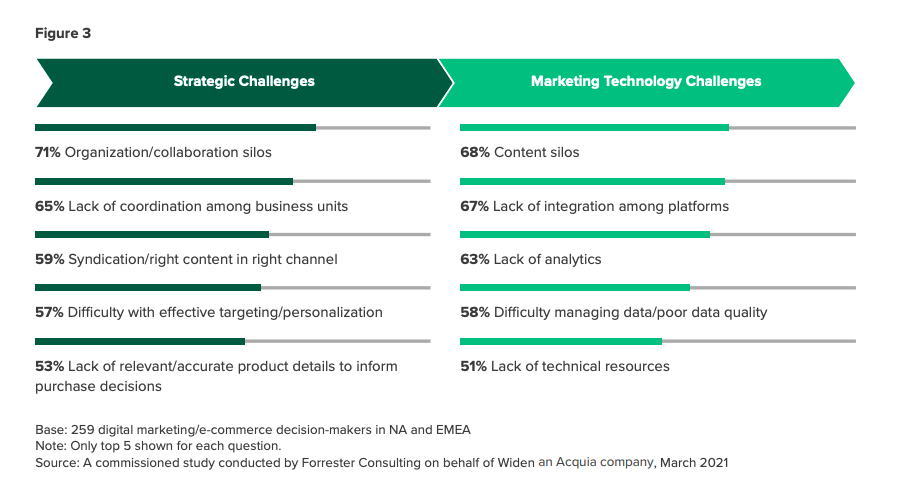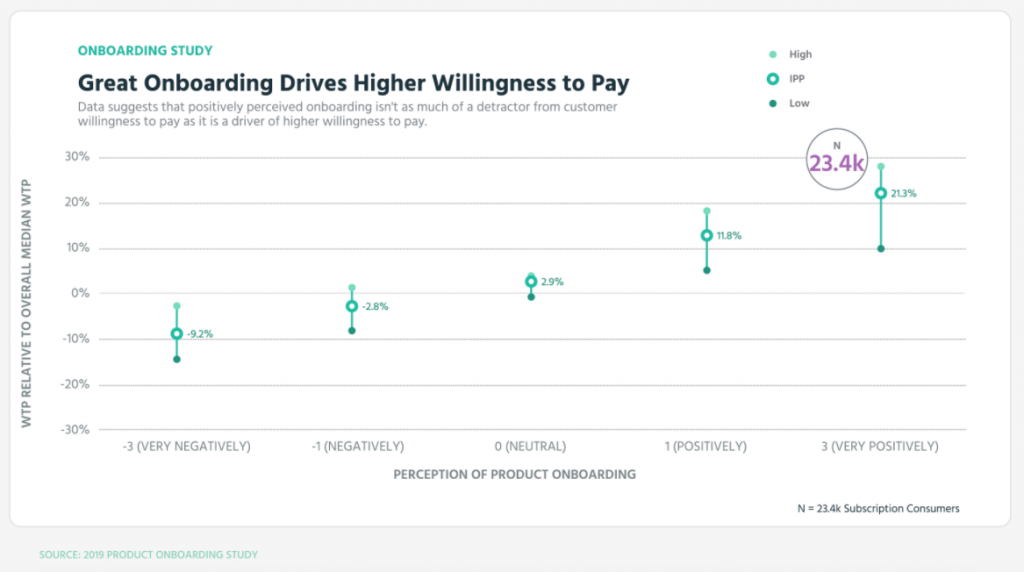Product content strategy is a little different from the conventional web content strategy because it brings a lot of product-centric approach to contribute directly to the product metrics. New roles in the product content category such as in content design and UX writing have brought content processes a lot closer to the design and engineering.
Product content and design are planned together as part of the product strategy which means that sometimes you cannot separate content from design. A variety of new tools support this practice, such as String, Ditto, and many more.
Product content strategy is the product-centric content strategy across the teams and functions for discovery and research, for content’s role and plan in product and all adjacent including GTM and support, content-driven design and UX, and for its role in the product metrics.
In April 2021, Acquia published a research report—Enrich Customer Experiences With Product Content, (Source: A commissioned study conducted by Forrester Consulting on behalf of Widen an Acquia company, March 2021). The report focused on the role of product content in the customer experience, and the findings show different types of content-specific concerns in the organizations.
The top content priorities of survey respondents are to improve ROI, insights, and experiences.

The study was carried among the ecommerce brands and that is why they talk about DAM and PIM for product content management. However, the findings show that we as product content strategists can apply these learnings to many organizations in other domain as well.
The challenge
The way product content is published and distributed across channels whether as part of their GTM strategy, or the random product footprints such as on social media or in community groups, the customers start their interaction with the brand in any context, anywhere, and anytime.
It means that organizations do not have all the control over where the customers might find a product, how they interpret the message, how they process it, and how they make buying decisions. This is why the organizations find it challenging to put together a unified message and positioning in the context of the customers’ needs and goals. Consider a B2B SaaS where:
- the marketing model is ABM—Account Based Marketing.
- they have a public pricing page that offers a free trial for 30 days.
- the GTM team evaluates a few vendors and they decide to set up Hubspot.
- the product discovery team hosts research sessions in Miro, and then plan internal workshops for data synthesis.
- the design team works closely with the UX writers for the right message on product screens
- Everybody has an eye on their teams’ KPIs, very few follow product metrics
- the RevOps is watching the dashboards
- the DevOps propose a new tool for integration-security lifecycle; the head of engineering throws a hat with a list of headless CMS
- The support is watching too
The product content is fragmented in the absence of product content strategy. This is why Content Operations (ContentOps) is making news recently and I see that ContentOps will play a huge role in enabling the product content strategy.
Marketing
Monday’s marketing is a good example to discuss the role of product content. If you see it in a content strategist’s lens, the focus on keywords and driving traffic for the funnel does not always excite us but let’s accept that if done well and if aligned well with the product, it can really scale a business.
Looking at these numbers, I guess Monday’s marketing team are more likely to influence the product content directions for inputs and participation, rather than the product content team taking some important calls for their marketing content. This is why I vote for working towards the product vision, as Marty Cagan explains it so well. Some of Marty’s writings talk about their experience in Silicon Valley but the practices generally apply for product teams anywhere in the world.
Product content strategy helps the teams in identifying the key drivers that build the organization’s growth sentiment. Being a generalist, I am not a strong believer of how product content can be done a lot differently in sales-led vs product-led vs research-led, vs vision-led companies, but it is always a good idea to keep an eye on what contributes the most to the bottomline.
Since I have been working in the product-centric roles the recent years, I plan my work around the role of content in product positioning, onboarding, retention, and growth, and how content and design make a great product. It sounds funny that I receive many proposals for a marketing role—content marketing, or brand positioning though I never position myself as a marketer.
Every. Single. Time.
— Vinish Garg 🎗 (@vingar) August 3, 2020
Every time someone approached me for 'content marketing services', their org needed 'content strategy services'. #contentstrategy #contentdesign #contentmarketing
Regardless of the role, there is always a product content strategist in me working on design, positioning, marketing, sales narrative, support center, UX, research, or anything in digital products.
A SaaS pricing page
In a SaaS, their pricing page is the lifeblood for their success. The SaaS pricing page is an interesting mix of product marketing, design, product content strategy. A well designed pricing page is a good example of how we can build trust and give confidence to the customers, by answering their basic questions, and encouraging them to sign up.
My guess is that the pricing pages of even the bigger #SaaS teams are being designed by their marketing or revenue teams, without any role by their content strategists or content designers. Always saw @SlackHQ @MIroHQ and many others pricing as complex and no-easy to understand👇🏼
— Vinish Garg 🎗 (@vingar) February 24, 2021
A majority of SaaS pricing pages are poorly designed because their product marketers design these pages without a product content strategist in the organization (or without their direct role in the pricing page). Product content strategy adds more clarity, structure, and the interactions for the conversions goals.
Makes design systems more relevant for the organization
Design systems are the flavor of the season. Organizations invest in a design system with the best naming conventions, for the structure and standards, and then the documentation of design systems for an easy reference. Clarity and Into Design Systems are two very good conferences that specifically take the design systems knowledge forward.
Product content strategists can help the design systems being more open to multiple functions for their contribution, feedback and support, and for making the design system as a strategic business asset. Since the product content teams work on a holistic view of content and its role in the product metrics, they can work with the design system teams to make it as a growth lever—making it as a system in true sense (I wrote it earlier this week).
Content for product metrics
Many organizations particularly in the SaaS category have clear product metrics for the CAC (Cost to Acquire a Customer), LTV (Lifetime Value of customer), MRR (Monthly Recurring Revenue), ACV (Annual Contract Value), and few more. We can imagine how these unit economics are so important for the organization’s growth and investments, which means for the product strategy for way forward.
Product content strategists can tie their work to these product metrics, to make their work directly measurable for the ROI. For example, what happens when the customers sign up, what is their account activation rate, and other design metrics that product teams use.

Source: Profit Well wrote about onboarding and product metrics
We are best positioned to find the experience gaps, design latency, competency gaps, and channel synchronization issues for what exactly hurts the product metrics and then identify the role of content—the content itself or when content is baked in code or design.
Yes, product content strategy binds everything together
The scope of work in product content strategy is multi-dimensional and it brings positive change in all the functions and teams in an organization.
- Product content which means the UX content within the product for the entire customer journey (UX Writing) for the customer onboarding for their goals. It includes planning strategic content that helps the organization retain the customers, by sharing right information at the right time whether within the product or by timely emails or as part of continuous discovery, or proactively upselling the benefits of upcoming changes in the product, and so on.
- Product marketing which includes planning and defining the message for the users for why they should care about an organization and its products or services, why they should sign up, and how the product helps them in their needs and goals. This includes the branded content that prepares the content for sign up, and then working with product teams to ensure that the brand promise aligns with the onboarding experience.
- Identifying the core product vision—product content strategy keeps different teams glued together, or mindful of the core product vision. It brings the right velocity in ProductOps, DesignOps, RevenueOps, DevOps, and all other operational workflows in the organization because the content flows internally at the right time for the right reasons.
In a lot of ways, content strategy means operationalizing everything in content design, UX writing, product marketing, and brand positioning.
— Vinish Garg 🎗 (@vingar) October 26, 2021
Product content strategy is often the missed opportunity in the organizations. It is as much up to the organizations as it is up to the content practitioners, to build the right framing and message for how we work, how we can work, and how it helps the organization.
Enabling product content strategy too is content strategy. This is a beautiful part of working on content without really working much on the words.
—
This topic is part of my advanced course in product content strategy, content design, and UX Writing. See the course details for how we can find and add more meaning to our work.
